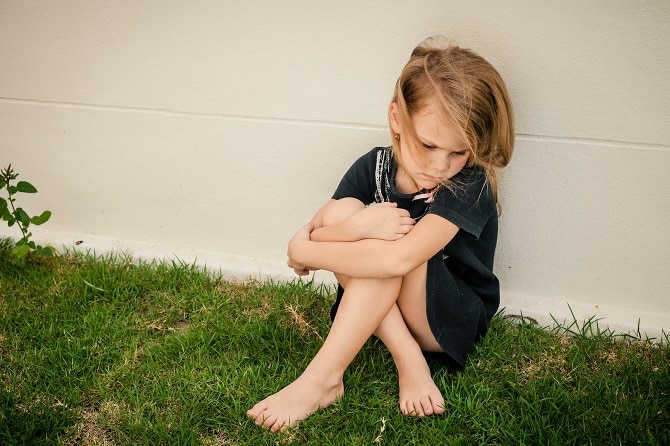Psycom – May 22, 2018
by Katie Hurley, LCSW
Social anxiety disorder (social phobia) isn’t simply a fear of making or interacting with friends. It’s actually characterized by an intense fear of social situations in which the child might be judged or scrutinized by others.
Children with social anxiety disorder experience intense feelings of anxiety about a number of different triggers including speaking in front of others, reading out loud, fear about being evaluated by others, fear of offending others, fear of embarrassment, and fear conversing with unfamiliar individuals. Children with social anxiety disorder worry in a lot of social situations (school, teams, play dates, enrichment classes, and even family reunions.)
Social anxiety disorder can cause significant distress for children and has a negative effect on academic performance, social relationships, self-confidence, and other areas of functioning. Children with social anxiety disorder are likely to avoid engaging in things like sports or other group activities with their peers for fear of negative scrutiny or embarrassment.
Parents can help children with social anxiety disorder by understanding the nature of the disease and teaching them how to cope with their symptoms.
Symptoms of social anxiety disorder
The median age at onset of social anxiety disorder is 13 years, and 75% have an age at onset between 8 and 15 years. The disorder can emerge out of a childhood history of social inhibition or shyness but can also be triggered by a traumatic experience, including bullying.1 Approximately 15 million Americans suffer from social anxiety disorder. 2
The defining feature of social anxiety disorder includes marked fear or anxiety about one or more social situations in which the person might be subject to possible scrutiny by others. Examples include social interactions, being observed by others, and performing in front of others. 3
Other symptoms of social anxiety disorder include the following:
- The person feels that he or she will act in a way or show anxiety symptoms that will be negatively evaluated
- The social situations always trigger fear or anxiety (in children this can manifest as tantrums, clinging, crying, freezing up, or failure to speak)
- Social situations are avoided or endured with intense feelings of fear and anxiety
- The fear or anxiety is out of proportion to the actual threat
- The fear, anxiety, and avoidance lasts for 6 months or more
- Causes clinically significant distress in social, occupational (school), or other areas of functioning
- Dread of social events that can occur weeks in advance
- Excessive clinging to familiar people
- Tantrums when faced with anxiety provoking social situations
- Blaming others for perceived social failures
- Physical symptoms: Blushing, racing heart, shaky voice, trembling, nausea, difficulty speaking
How to help your child cope with social anxiety disorder
The best first step to help your child cope with it is to name it. Children with social anxiety disorder know that they feel fearful and anxious in social situations, but they don’t always know why. Helping them connect the dots between emotional responses, physical symptoms, and triggers is an important first step toward learning to cope. Educating your child about the ways in which anxiety impacts thinking and behavior is a powerful lesson in learning to work through negative emotions.
– Teach relaxation strategies
Kids need to learn a variety of tools to use when feeling anxious and overwhelmed. It’s nearly impossible to use adaptive coping strategies when you’re dealing with intense physical symptoms of anxiety, so the first step is with work on learning to calm the anxious response.
- Deep breathing is the best way to calm rapid heart rate, shallow breathing and feeling dizzy. Teach your child to visualize blowing up a balloon while engaging the diaphragm in deep breathing. Count your child out to help slow the breathing (4 in, 4 hold, 4 out).
- Guided imagery: Your child can take a relaxing adventure in her mind while engaging in deep breathing. Tell a quick story in a low and even voice to help your child find her center.
- Progressive muscle relaxation: Anxious kids tend to tense their muscles when they’re under stress. Teach your child to relax her muscles and release tension beginning with her hands and arms. Make a fist and hold it tight for five seconds, then slowly release. Move on to the arms, neck and shoulders, and feet and legs.
– Teach cognitive reframing
Kids with social anxiety disorder are often overwhelmed by negative beliefs that reinforce their anxious thoughts. Their beliefs tend to fall into the following categories:
- Assuming the worst case scenario
- Believing that others see them through a negative lens
- Overreacting
- Personalizing
Teach your child to recognize negative thoughts and replace them with positive ones. If your child tends to say things like, “My teacher thinks I’m stupid because I’m bad at reading,” help him recognize the negative thought, ground it in reality (a teacher’s job is to help kids learn not judge them on what they already know), and replace it with a positive thought (“I’m having a hard time reading but my teacher will help me get better.”)
– Teach problem-solving skills
Children with social anxiety disorders tend to become masters of avoidance. They do what they can to avoid engaging in situations that cause the most anxiety. While this might seem like the path of least resistance, it can actually make the social anxiety worse over time.
Teach your child to work through feelings of fear and anxiety by developing problem-solving skills. If a child fears public speaking, for example, she can learn to practice several times at home in front of a mirror, have someone videotape her and watch it back, find the friendly face in the room and make eye contact, and use deep breathing to calm anxious feelings.
Help your child identify her triggers and brainstorm potential problem-solving strategies to work through those triggers.
– Work on friendship skills
While you can’t make friends for your child, you can help your child practice friendship skills. Practice these skills using role play and modeling to help your child feel at ease with peers:
- Greetings
- Sliding in and out of groups
- Conversation starters
- Listening and responding
- Asking follow up questions/making follow up statements
Seek professional help
If social anxiety disorder negatively affects your child’s ability to attend school, socialize with peers in or out of school, or affects other areas of functioning, it’s time to seek an evaluation from a licensed mental health professional. The good news is that social anxiety disorder is very treatable and kids can learn to cope with their symptoms and implement strategies that work across a wide variety of settings.



